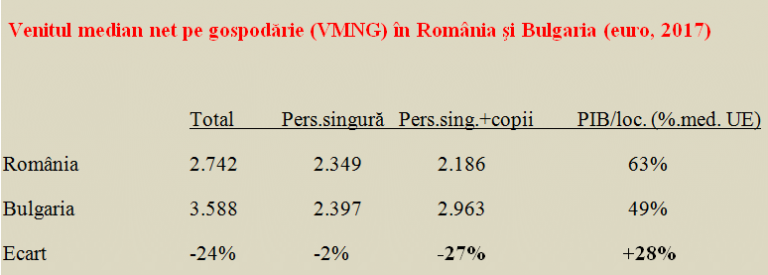 Eurostat has published the most recent data of EU member states on median net income by household. Romania ranks last in 2017, with only EUR 2,742, much behind Bulgaria (EUR 3,588) and at a far distance from the European average (EUR 16,359).
Eurostat has published the most recent data of EU member states on median net income by household. Romania ranks last in 2017, with only EUR 2,742, much behind Bulgaria (EUR 3,588) and at a far distance from the European average (EUR 16,359).
*
Dictionary:
Median net income by household refers to the amounts earned by a given household in a given region where half of these households earn more and the other half less. It can be used instead of average income or median income because it better reflects the economic situation in the area. The indicator is used to determine to what extent a family can afford living expenses.
*
The picture based on this indicator is very different from the one offered by GDP per capita at the parity of standard purchasing power compared to the EU average, the average reference level generally used to describe the relative economic situation of the population in a particular country. This is what we can see, very revealing if we make a comparison with Bulgaria.
*
- Median net income by household (VMNG) in Romania and Bulgaria (euro, 2017)
- Total Single person Single person with one child Single person + children GDP/inhabitant (% EU average)
- Romania
- Bulgaria
- Difference
*
Of course, it can be argued that there are problems with the methodology, maybe our neighbours from the south of the Danube are better than us to look good in statistics (otherwise, only as a colourful element, their compatriot Mariana Kotzeva is right the general manager of Eurostat).
Children – disadvantaged compared to voting segments
However, even so, let us thoroughly look at the negligible difference that remains for us between single people and how a reverse gap in terms of living standards is shaped (theoretically, resulting from GDP per capita) in the category of most vulnerable people, singles with children.
In the context of an excessive concern for retired voters in, we „managed” to reach a catastrophic percentage of 46.8% of children being at risk of poverty or social exclusion, plus the unwanted position of champions in terms of maximum risk of poverty difference between children and the overall population (along with Hungary, with 7 percentage points, of course, according to Eurostat).
Although we are better in terms of GDP per capita (where we have already exceeded Croatia and left Bulgaria much behind), we are successful in the counter performance to systematically position ourselves last by poverty indicators regardless of the economic performance. From where it is visible that it is not enough to make money, it also matters what you do with them, how you organize them, for what and for whom you use them.
And others, also from East
As a reference and in order for us to not feel alone in this game of figures showing where waters split between the richest and the poorest half in former socialist states, we also present a comparison that includes the other EU states positioned below the threshold of EUR 10,000 in terms of median net income by household (VMNG), in parallel with the much more publicized adjusted to country price levels.
*
- VMNG GDP /capita
- Hungary
- Poland
- Lithuania
- Croatia
- Latvia
- Slovakia
- Czech Republic
- Estonia
*
If we recover 82% we catch up with Hungarians, with a 117% leap we reach Poles, with an advance of +126% we meet with the Croatians whom we surpassed in terms of GDP per capita and with an advance of + 162% we can get in line, in terms of poverty and social inequalities, with Slovaks, who have, like us, many cars and joined the Eurozone around 2009.
In 2016, the living standard in Bucharest-Ilfov region was 139% of the EU average (based on definitive GDP data), according to GDP per capita at the parity of purchasing power standards (adjusted to national price levels). Our capital city area surpassed metropolitan areas of Europe such as Madrid (125%), Berlin (118%), Rome (110%) or Lisbon (102%), in comparable terms.
If we make the correlations needed to obtain the national average, we can notice that in some limited areas we are better even than many Western states, while in others there are very large areas of abject poverty. A reason why (also in Eurostat data) we are present (surprise?) with the highest poverty risk of (25.3% in our case compared to 22.9% for Bulgarians).
Under these circumstances, does it still make sense to ask ourselves how we stand with social cohesion, why Romanians leave the country and why, despite the fact they generate overall enough wealth, we do not quite modernize our attitude in organizing the society and placing a country on a sustainable basis by following a Western European model?











